
Super Mario World, known in Japan as Super Mario World: Super Mario Bros. 4, is a 1990 platform game developed by Nintendo EAD and published by Nintendo for the Super Nintendo Entertainment System (SNES). The player controls Mario on his quest to save Princess Peach and Dinosaur Land from the series' antagonist Bowser and the Koopalings. The gameplay is similar to that of earlier Super Mario games; players control Mario through a series of levels in which the goal is to reach the goalpost at the end. Super Mario World introduces Yoshi, a ridable dinosaur who can eat enemies.

Princess Peach is a character in Nintendo's Mario franchise. She was created by Shigeru Miyamoto and introduced in the 1985 original Super Mario Bros. game as Princess Toadstool. She is the princess regnant and head of state of the Mushroom Kingdom, where she resides in her castle along with Toads. Since her debut, she has appeared in the majority of Mario video games as the main female character and the romantic interest of Mario. She has been voiced by Samantha Kelly since 2007.
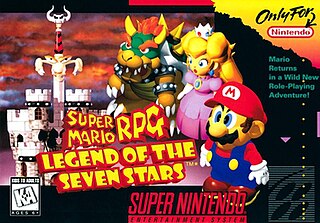
Super Mario RPG: Legend of the Seven Stars is a 1996 role-playing game developed by Square and published by Nintendo for the Super Nintendo Entertainment System (SNES). It was the final Mario game published for the SNES. The game was directed by Chihiro Fujioka and Yoshihiko Maekawa, produced by Shigeru Miyamoto, and scored by Yoko Shimomura.

Paper Mario is a 2000 role-playing game developed by Intelligent Systems and published by Nintendo for the Nintendo 64 home video game console. Paper Mario is the first game in the Paper Mario series. First released in Japan in 2000 and then internationally in 2001, Paper Mario was later re-released for Nintendo's Wii Virtual Console in July 2007, the Wii U Virtual Console in April 2015, and the Nintendo Switch Online + Expansion Pack on December 10, 2021.
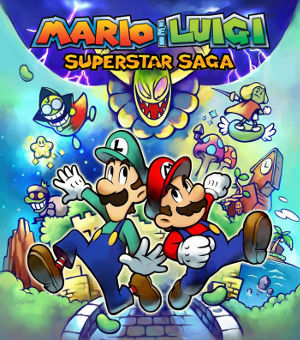
Mario & Luigi: Superstar Saga is a 2003 role-playing game developed by AlphaDream and published by Nintendo for the Game Boy Advance. It was re-released for the Wii U's Virtual Console in 2014, Nintendo Switch Online Service in 2023, and remade for the Nintendo 3DS as Mario & Luigi: Superstar Saga + Bowser's Minions in 2017. In the game, Mario and Luigi travel to the Beanbean Kingdom in order to combat Cackletta and Fawful, who stole Princess Peach's voice for the purpose of harnessing the power of a special artifact called the Beanstar.
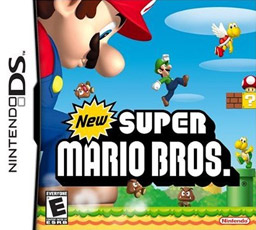
New Super Mario Bros. is a 2006 platform game developed and published by Nintendo for the Nintendo DS. It was first released in May 2006 in North America and Japan, and in PAL regions in June 2006. It is the first installment in the New Super Mario Bros. subseries of the Super Mario franchise and follows Mario as he fights his way through Bowser's henchmen to rescue Princess Peach. Mario has access to several old and new power-ups that help him complete his quest, including the Super Mushroom, the Fire Flower, and the Super Star, each giving him unique abilities. While traveling through eight worlds with more than 80 levels, Mario has to defeat Bowser Jr. and Bowser before saving Princess Peach.
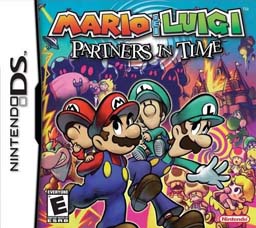
Mario & Luigi: Partners in Time is a role-playing video game developed by AlphaDream and published by Nintendo for the Nintendo DS handheld game console in late 2005. It is the second game in the Mario & Luigi series, and is the prequel/sequel to the 2003 Game Boy Advance game Mario & Luigi: Superstar Saga. The game was later re-released for the Wii U as a Virtual Console title in 2015, available for purchase from the Nintendo eShop.
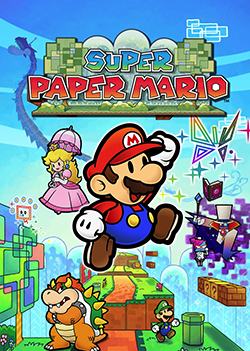
Super Paper Mario is a 2007 action role-playing game developed by Intelligent Systems and published by Nintendo for the Wii. It is the third installment in the Paper Mario series and the first Mario game on the Wii. The game follows Mario, Peach, Bowser, and Luigi as they attempt to collect Pure Hearts and stop Count Bleck and his minions from destroying the universe.

Super Mario is a platform game series created by Nintendo starring their mascot, Mario. It is the central series of the greater Mario franchise. At least one Super Mario game has been released for every major Nintendo video game console. However, there have also been a number of Super Mario video games released on non-Nintendo gaming platforms. There are more than 20 games in the series.

Mario & Luigi: Bowser's Inside Story is a 2009 role-playing game developed by AlphaDream and published by Nintendo for the Nintendo DS handheld game console. It is the third game in the Mario & Luigi role-playing series. It uses the interactive screens of the DS in some of its gameplay mechanics while also introducing several elements that would be used in the series' future gameplay.

Mario is a Japanese multimedia franchise created by Japanese game designer Shigeru Miyamoto for video game company Nintendo, which produces and publishes its installments. Starring the titular Italian plumber Mario, it is primarily a video game franchise but has extended to other forms of media, including television series, comic books, a 1993 feature film, a 2023 animated film, and theme park attractions. The series' first installment was 1983's Mario Bros., although Mario made his first appearance in 1981's arcade game Donkey Kong and had already been featured in several games of the Donkey Kong and Game & Watch series. The Mario games have been developed by a wide variety of developers, including Nintendo, Hudson Soft, and AlphaDream. Mario games have been released almost exclusively for Nintendo's various video game consoles and handhelds, from the third generation onward.

Toad, known in Japan as Kinopio, is a character from the Mario franchise. The character was created by Japanese video game designer Shigeru Miyamoto, and is portrayed as a citizen of the Mushroom Kingdom and one of Princess Peach's attendants. Toad is typically a non-player character who assists Mario and his friends, but he occasionally appears as a protagonist.
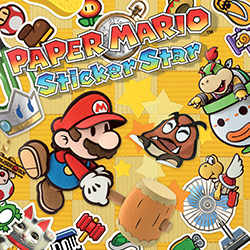
Paper Mario: Sticker Star is a 2012 role-playing game developed by Intelligent Systems and published by Nintendo for the Nintendo 3DS. It is the fourth installment in the Paper Mario series and part of the larger Mario franchise; it is the first game in the series released on a handheld console. In the game, the protagonist Mario and a new ally named Kersti travel across the Mushroom Kingdom to retrieve the six Royal Stickers scattered by Bowser. The game was released in November 2012 in North America and December 2012 overseas.
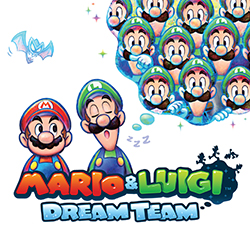
Mario & Luigi: Dream Team, known in Europe and Australia as Mario & Luigi: Dream Team Bros., is a 2013 role-playing video game developed by AlphaDream and published by Nintendo for the Nintendo 3DS. It is the fourth installment in the Mario & Luigi series, a part of the larger Mario franchise. The game's story follows Mario and his brother Luigi who, after being invited to Pi'illo Island for a vacation, become embroiled in a journey to retrieve a powerful artifact before Bowser and Antasma use it for evil intentions. The gameplay takes place from a top-down perspective and has the player controlling Mario and Luigi simultaneously, solving puzzles and platformer sessions, and overcoming turn-based battles across Pi'illo Island, the game's overworld. The player also makes use of Luigi's dreams, called the "Dream World", where gameplay shifts to a two-dimensional side-scrolling perspective and emphasizes using Luigi-based gimmicks to their advantage. Combat in both worlds is turn-based.

Paper Mario: Color Splash is a 2016 role-playing game developed by Intelligent Systems and published by Nintendo for the Wii U console. It is the fifth installment in the Paper Mario series, within the larger Mario franchise. The story follows Mario and his new ally Huey on a quest to save Prism Island and rescue Princess Peach from Bowser.
Paper Mario is a video game series and part of the Mario franchise, developed by Intelligent Systems and produced by Nintendo. It combines elements from the role-playing, action-adventure, and puzzle genres. Players control a paper cutout version of Mario, usually with allies, on a quest to defeat the antagonist, primarily Bowser. The series consists of six games and one spin-off; the first, Paper Mario (2000), was released for the Nintendo 64, and the most recent, Paper Mario: The Origami King (2020), for the Nintendo Switch.

Paper Mario: The Origami King is a 2020 role-playing game developed by Intelligent Systems and published by Nintendo for the Nintendo Switch console. It is the sixth game in the Paper Mario series, which is part of the larger Mario franchise. The story follows Mario and his friends as he sets out on a journey to prevent the Mushroom Kingdom from being transformed into origami. To do so, Mario must free Princess Peach's castle from five decorative streamers that extend across the kingdom.
Mario & Luigi is a series of role-playing video games developed by AlphaDream and published by Nintendo for the latter's various video game handheld consoles. The series is a spin-off from Nintendo's trademark Super Mario series and stars the titular characters Mario and Luigi. The games' stories follow the two on a quest to defeat an antagonist, sometimes Bowser but usually a new character. It began in 2003 on the Game Boy Advance with Mario & Luigi: Superstar Saga, with the latest original installment being Mario & Luigi: Paper Jam in 2015 for the Nintendo 3DS. Two other titles in the series, including Superstar Saga, had an additional remake for the Nintendo 3DS. Mario & Luigi: Bowser's Inside Story + Bowser Jr.'s Journey was the last game in the series before AlphaDream declared bankruptcy in 2019, and remains the latest installment in the series.
















